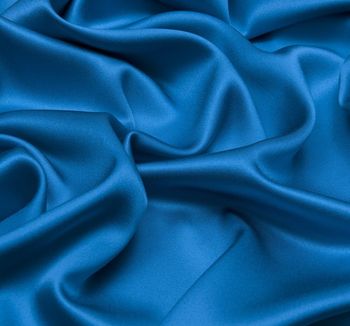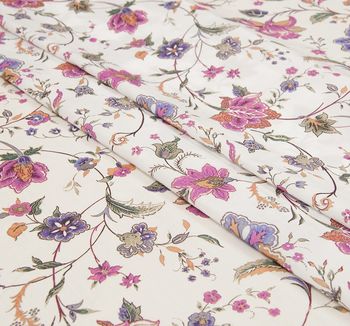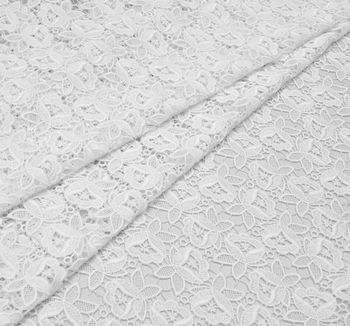Silk is a timelessly trendy natural fabric woven from the cocoons of silk worms. The world’s most famous fashion brands regularly apply it for various men’s and women’s outfits earning the admiration of the audience.
Lace Fabrics
Lace is a sheer and delicate fabric. It features an openwork pattern and is usually made of natural materials: silk, cotton, wool, viscose. Depending on a type, lace ranges from lightweight to heavy.
Among the most popular designs are floral, botanical and geometric. When sewing clothes, lace can be used as the main material or for decorating hems. Here is an overview of lace types, uses, pros and cons of this fabric, leading manufacturers and latest fashion trends.
What Are the Types of Lace?
Nowadays, lace fabric is widely used not only in bridal fashion, but also for finishing casual clothes, sewing evening or festive outfits, and even for lingerie.
Here are the main types of lace, which are extremely popular today:
Chantilly lace is a type of lightweight lace (30-180 g/m 2) on a net background, usually with a floral pattern, outlined with silk threads. The name of lace came from French city Chantilly. This type of lace is a timeless classic. Sheer or semi-sheer, with scalloped edges, it is perfect for bridal fashion, airy evening gowns or overlays.
Guipure lace is a heavy type of lace (70-400 g/m 2, wool guipure lace can weigh up to 800 g/m 2), which features a raised design. It does not have a net background like Chantilly lace, elements of guipure lace are connected with braids. It’s a great choice for casual and evening dresses, blouses, skirts, jackets and outwear.
Lyon lace is a type of lace made of pure cotton with the weight of 90-150 g/m 2. This lace has a complex pattern, woven on a lightweight tulle and outlined with a cord thread. It is produced on the original looms, which remained from the 19th century. Perfect for a wedding dress.
Corded lace is a type of lace outlined with a soutache cord, which creates a volumetric effect. The weight is 45-185 g/m 2. Choose it for a wedding or evening dress, for decorating of any attire or as overlay material.
Embroidered lace is perfect for evening wear. The weight is 100-550 g/m 2. Lots of beads, sequins, crystals, ribbons, satin stitch embroidery and more create a festive look. It is extremely popular for fashioning haute couture gowns. Ideal for evening wear, bridal gowns.
Lace applique is a piece of openwork material. The weight depends on a décor, with beads and bugles lace appliques can have the same weight as embroidered lace.
Lace fabric collection at Tissura
Another classification refers to handmade laces and their production method. There is needle lace, bobbin lace, crochet and tatting.
Needle lace. This type of lace is created with a needle and thread based on the pattern, usually applied on a parchment paper.
Bobbin lace is made with threads, wrapped around bobbins. It is also known as pillow lace.
Crochet from French means 'small hook', as the production process involves using a crochet hook when the lace is handmade. It also can be manufactured on a loom as strips of lace material, which will be sewn together.
Tatting lace is a type of handcrafted lace, made of a series of knots and loops with a tatting shuttle.
Stretch Lace Fabric
Stretch lace fabric usually contains elastic fibers – spandex or lycra (elastane). Due to these fibers, lace has a great stretch factor and becomes durable. Lace with elastic fibers is absolutely versatile. Use it for sleeves, adorn your lingerie, decollete or use for multilayered outfits, coats, skirts, dresses and more.
African lace
African lace is a type of industrial embroidery on cotton, sateen, linen made by Swiss or Austrian manufacturers for the Western Africa market. European manufacturers decided to choose vibrant colors, typical for traditional clothing in the region. This embroidery looks very similar to guipure but it is not lace in the conventional sense. The name Nigerian lace, which is often used, is explained by the fact that Nigeria was one of the major export markets for Swiss companies. The other names of this embroidery are Austrian lace or Swiss lace.
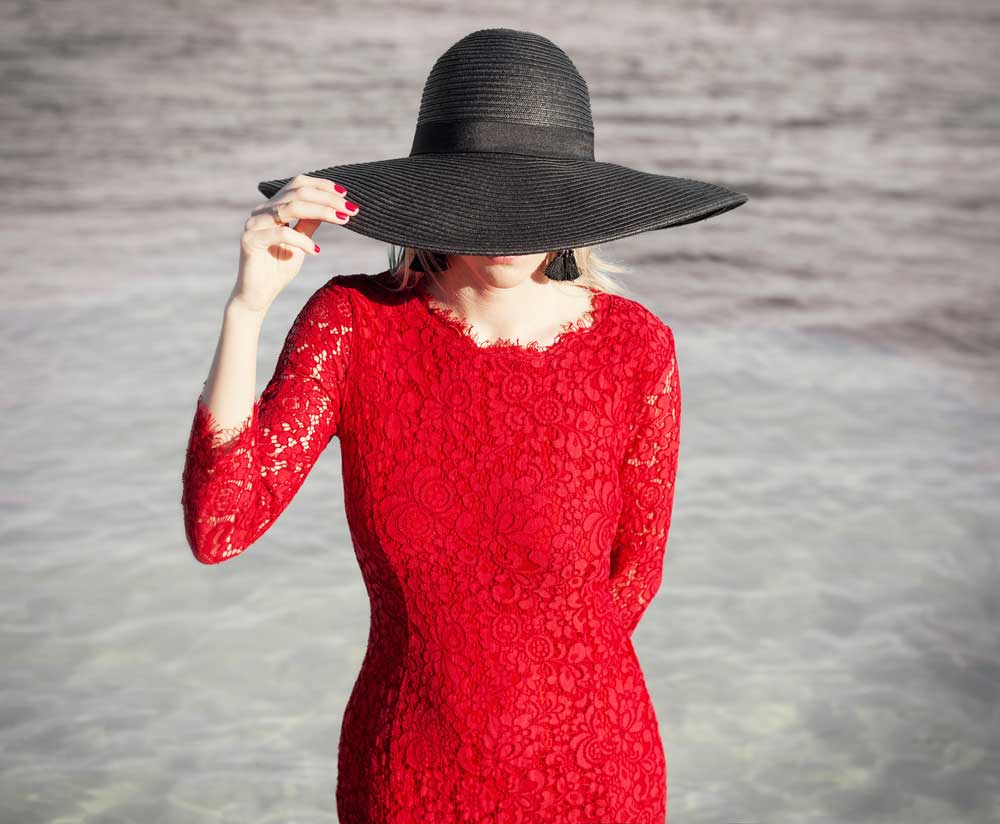
Pros and Cons of Lace
Laces are works of textile art. They bring beauty and pleasure to everyday life. Nevertheless, lace has both pros and cons. Here are the main of them:
Pros:
Beautiful. It looks stunning and feminine, perfect for a romantic look.
Versatile. The material is an ideal choice for evening and casual clothes, finishing and more.
Airy. It is breathable and has a pleasant texture.
Festive. Casual clothes decorated with lace look stunning.
Cons:
Fragile. It can be easily damaged.
Price. It is not a secret that laces made of natural materials by leading European manufacturers are expensive.
Transparency. It’s possible to use lace for separate elements or in combination with other materials. One may also insert a lining for more opacity.
Labor-consuming care. Dry-cleaning will be the best option, but a hand wash is also possible. Dry any garment with lace horizontally.
Properties and qualities
Lace is an openwork fabric handmade or machine-made. Depending on a type, its weight is from lightweight to heavy. It is breathable, sheer and may require a lining. The lace is soft to the touch, especially if made with silk, cotton or wool. With synthetic fibers it is more durable. Metallic threads add shimmering. The typical patterns are floral and botanical, but the design can often be geometric, ornamental, with stripes and waves, checks and paisley. The lace fabric is perfect for evening, bridal and casual wear, home textiles, lingerie, finishing.
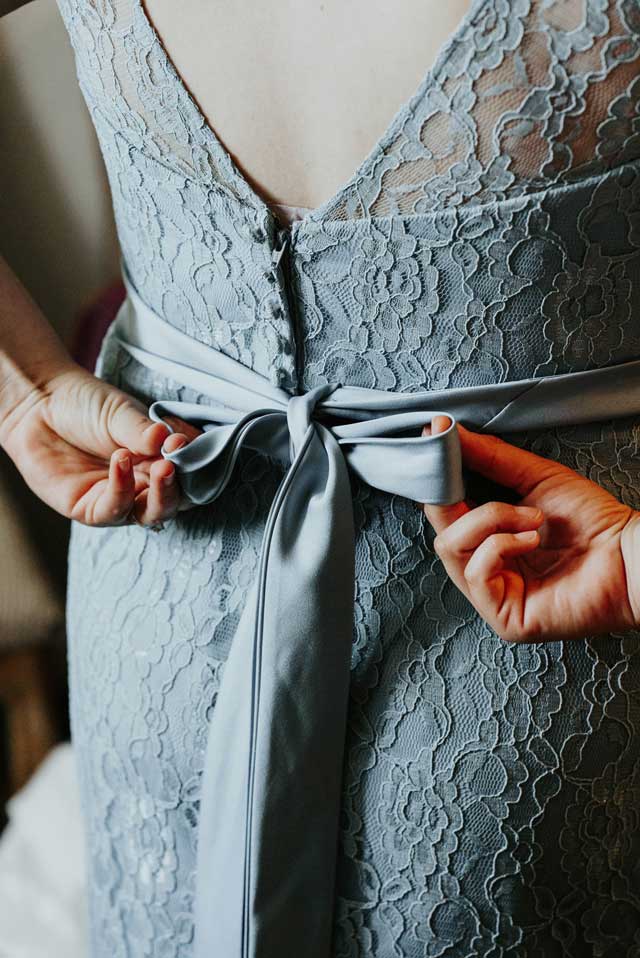
How to Care for Lace Fabric?
Lace fabric requires delicate care. Dry-cleaning is preferable. First of all, check the care label before washing. If hand wash is allowed, choose a gentle cleaning agent, use cold water, and dry on a towel after washing. If the lace is machine washable, select the delicate mode, use a wash bag and mild detergent. In case of improper care, for example, if a temperature of the water is higher than recommended, shrinkage is possible. Note, embroidered lace is not washable.
If possible, try to avoid ironing. It is especially important in case the lace contains synthetic fibers, because they can melt. If you decided to use iron, note the lace should be treated very carefully. Put the lace on a towel and place a press cloth or a plain cotton fabric between the iron and lace. Choose the proper temperature. If you want to dry the wet lace with iron, gradually raise the temperature from cool to cool-medium. When the lace is almost dry, put the iron aside. To avoid stretching, dry heavy lace apparel flat.
Top-5 Lace Fashion Trends 2018/2019
Lace is one of the favorites among fashion designers. The 20 th century has finally brought lace into everyday life.
Coco Chanel: “I consider lace to be one of the prettiest imitations ever made of the fantasy of nature; lace always evokes for me those incomparable designs which the branches and leaves of trees embroider across the sky, and I do not think that any invention of the human spirit could have a more graceful or precise origin”.
Here are the hottest fashion trends for this and upcoming season:
• Lingerie inspired clothes. Dresses and blouses with lace which show the beauty of woman’s body are among the hottest fashion trends.
• Total transparent look. Lightweight Chantilly lace is ideal for sewing airy dresses. Made without a lining, it will be the last word in fashion.
• A tiered skirt. This year a voluminous skirt is on all runaways. One of the best ways to decorate its hems is lace trims. The most ultra-modern color for lace trims is black.
• Fashion looks, inspired by the Victorian era. It means that the romantic and feminine garments are very popular and it is impossible to imagine fashion runways without lace – dresses, skirts, sleeves and even shoes, covered with this delicate fabric. By the way, Queen Victoria adored lace and even introduced a new bridal trend – she married Prince Albert in a stunning white dress and veil, embellished with lace.
• 3d floral lace fabric. Without a doubt, flowers are the best motif for a lace pattern. There is a keen interest in embroidered lace – rose-like coiled ribbons, gauzy petals from lingerie fabrics, and heavy appliques on a delicate net.
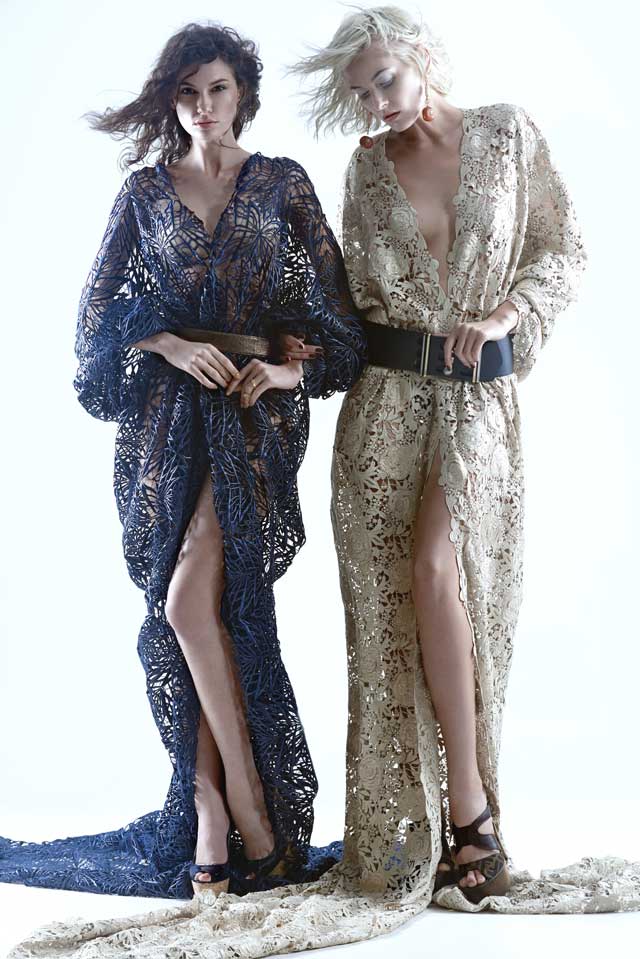
Famous Lacemakers
Europe is a birthplace of lace fabric. There is a long tradition of manufacturing with secrets, unique patterns and techniques. Some of the lacemakers even use the centuries-old looms. Here are the renowned manufacturers from France, Austria, and Italy with types of lace they make:
|
Manufacturer |
Country |
Types of lace |
Uses of lace |
|---|---|---|---|
|
Sophie Hallette |
France |
Chantilly, guipure, corded, embellished |
Evening, bridal gowns, ball gowns, overlay material |
|
Riechers Marescot |
France |
Chantilly, guipure, corded, embroidered |
Exclusive evening dresses and bridal gowns, finishing |
|
Solstiss Sa |
France |
Chantilly, corded, embroidered, guipure, scalloped lace trims |
Eveningwear, wedding and ball gowns, finishing |
|
HOH |
Austria |
Guipure, corded, sequined |
Eveningwear, casual skirts, dresses, tops, jackets, overlay material, finishing |
|
Marco Lagattolla |
Italy |
Silk Chantilly lace, macrame, embroidered, lace trims |
Eveningwear, bridal dresses, lingerie, accessories, finishing |
Tissura Collection
Tissura cooperates with leading lace manufacturers directly to offer the widest color range, patterns, and designs, constantly extending its collection with new arrivals.
Sophie Hallette is one of the major manufacturers, renowned for the high-quality French lace with traditional floral patterns. Chantilly lace is a hallmark of the brand. It is a good match for different types of fabrics. For example, Chantilly lace will look perfect with lightweight chiffon, crepe de chine and organza for a summer dress or skirt, with silk satin for a luxurious blouse or lingerie. The company has been working for more than a century and cooperated with the leading fashion houses like Christian Dior, Pierre Balmain, Jeanne Lanvin. Among the celebrities who chose the lace by the famous French manufacturer for their outfits were Marilyn Monroe, Jackie Kennedy, Elizabeth Taylor, Catherine Middleton, Amal Clooney. Sophie Hallette also produces stunning embroidered laces.
Riechers Marescot is a manufacturer of luxurious lace fabrics, a part of Sophie Hallette company since 1997. It features original designs of laces, made on 19th century Leavers looms. Embroidered lace is an ideal choice for haute couture or luxurious evening wear. Exclusive trims with beads, Swarovski crystals, pearls, appliques, sequins can be used to adorn accessories or hems of clothes for a festive look.
Solstiss Sa is a French company, established in 1974 by four lace makers to produce exquisite lace in the best traditions of the Northern France. The manufacturer offers more than 6,000 original patterns and 30,000 colors, producing Chantilly, corded, embroidered, guipure, scalloped lace trims. Tissura has a great collection of corded laces made of cotton, which is perfect for finishing edges of any garment. Medium weight, they go well with dense fabrics as cotton, crepe and jacquard. White corded lace is a lovely choice for a bridal gown.
HOH is the renowned manufacturer of high-end embroidered fabrics, embellished lace, guipure, fashion trims. If you are going to sew something unique like a haute couture dress, you can choose an exclusive appliqued, embroidered or sequined lace to make an eye-catching outfit. Our online shop offers a wide range of guipure laces and trims by this legendary Austrian manufacturer. Guipure is a heavy type of lace, it looks well with suiting fabrics like crepe, twill, jacquard, cotton poplin and perfect for an elegant dress or jacket. Lace trim will be a nice detail for decoration of necklines, hems or sleeves.
Marco Lagattolla is the Italian manufacturer of premium silk Chantilly lace and lace trims, cotton macrame lace, and tulle made on Valencienne looms of the 19 th century. The products of the company are desirable for evening wear, overlays, lingerie, ready-to-wear apparel, finishing accessories.
Choose your favorite type, buy online lace fabrics and make a true fashion masterpiece. From glamorous party to wedding, you surely will find the lace you dreamed of!
Corded lace fabric, 130 € (164 US$) per one running metre
Cotton lace fabric, 179 € (226 US$) per one running metre
Chantilly lace fabric, 164 € (207 US$) per one running metre
Guipure lace fabric, 238 € (300 US$) per one running metre
How to stay cool on a hot summer day? Wear fabrics built for the heat. Cotton, linen, viscose, silk – there are dozens of summer-friendly materials you can choose for your wardrobe. The best fabric to opt for when the temperature rises should be breathable and comfortable.
The wedding dress is one of the most important clothing items a woman gets to choose in her lifetime. It can be made of silk or cotton, lace or tulle, be strewn with sequins or embroidered with beads.
.jpg)
.jpg)
.jpg)
.jpg)
